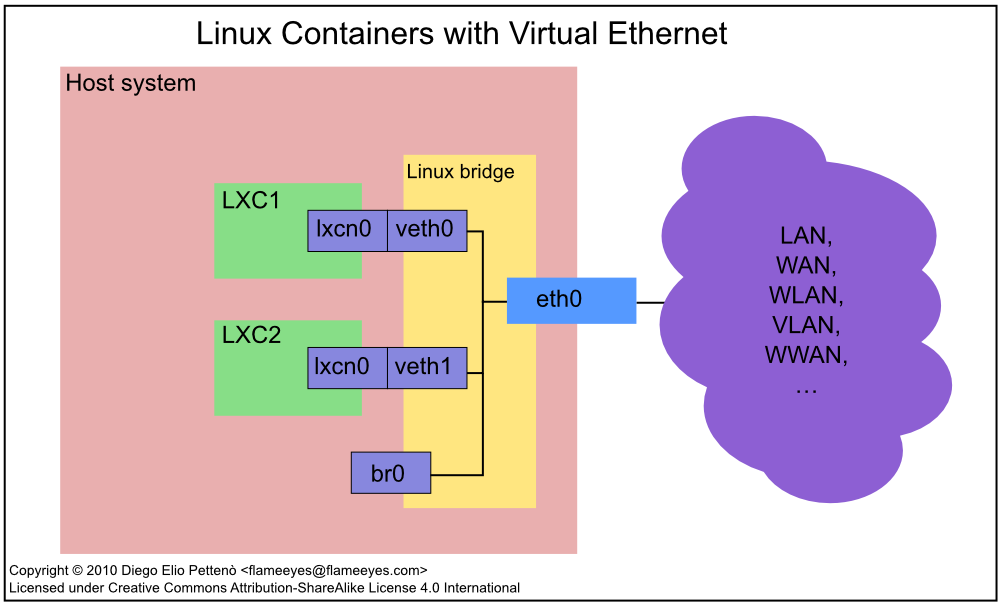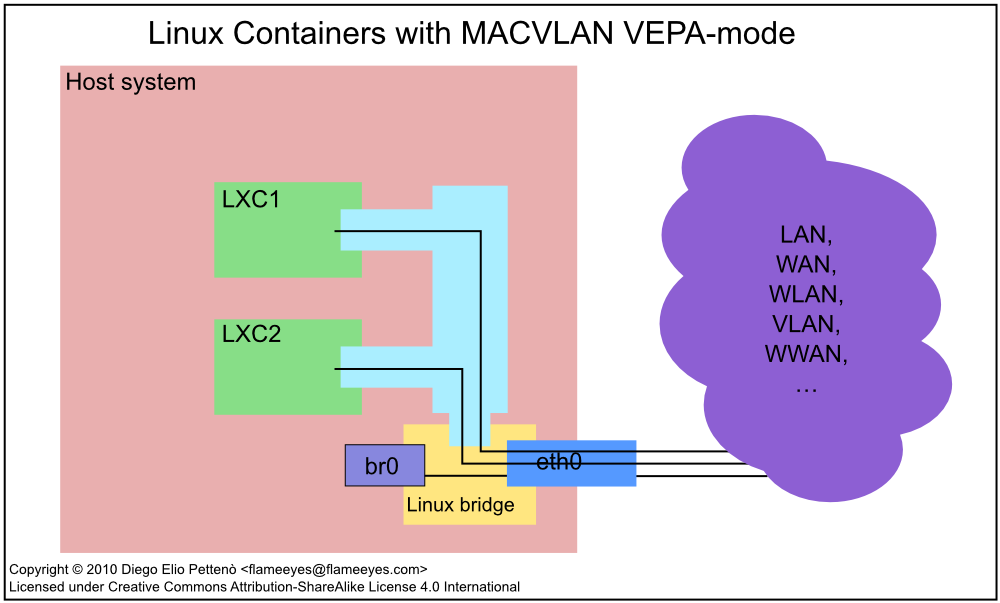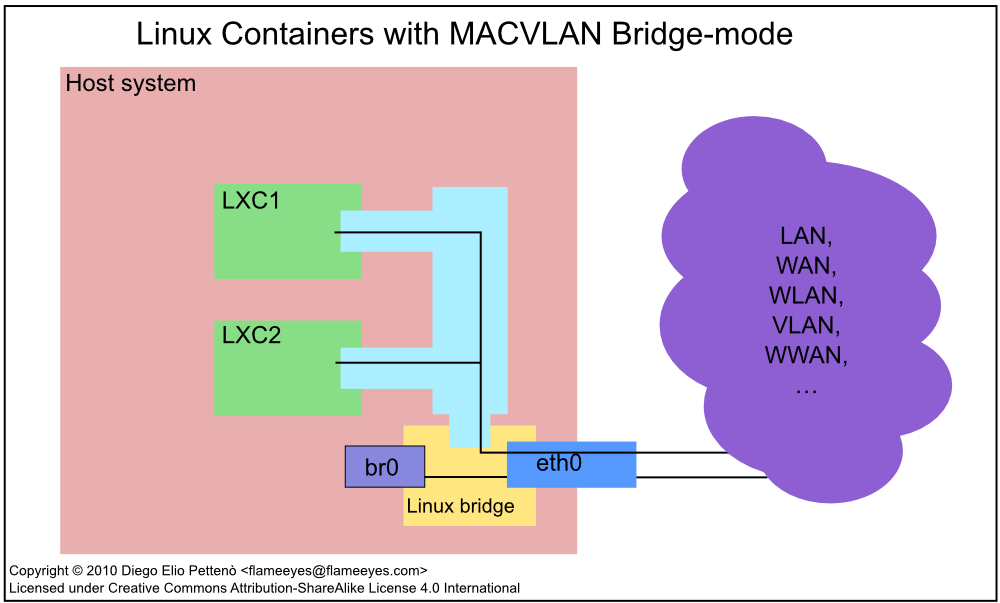So, at the moment I start writing this (and that’s unlikely to be the time I actually post this, given that I see now it could use some drawings) it’s early in the morning in Italy and I haven’t slept yet – a normal condition for me especially lately – but I have spent a bit bouncing ideas around with ferringb, Ramereth and Craig for what concerns Linux Containers (LXC). Given that, I’d like to point point out a couple of things regarding networking and LXC that might not have been extremely obvious before.
First of all, of the four networking types supported by LXC, I only could try two, for obvious reasons: phys is used to assign a particular physical device to the container, and only works if you have enough physical devices to work with, vlan requires a device able to do vlan tagging. This leaves us with veth (virtual ethernet), and macvlan (mac-address based virtual lan tagging). The former is the most simple setup, and the one I’ve been using; it creates a pair of devices, one of which is assigned within the container, and the other which is assigned to the host; you can then manage that device exactly like any other device you have on your system, and in my case that means it’s added to the br0 bridge where KVM instances are also joined. LXC allows for defining the bridge to join directly in the configuration file.

The macvlan mode is supposed to have smaller overhead because the kernel knows the mac address assigned to the single interfaces beforehand; on the other hand setting it up is slightly harder; in particular, there is one further mode parameter that can be set, in either vepa (Virtual Ethernet Port Aggregator) or bridge mode; the former isolates the container, like they were a number of different hosts connected over to the network segment, but disallows the various containers from talking with one another; on the other hand the latter mode actually creates a special bridge (not to be confused with the Linux bridge used above with virtual ethernet devices), that allows all the containers to talk with one another.. but isolates them from the host system

You end up having to choose between the performance of network-to-container and that of host-to-container: in the first case you can choose macvlan, reducing the work the kernel has to do, but requiring you to route your own traffic to the container with an outside router; in the second case you use veth and make the kernel handle the bridge itself. In my case, since the containers are mostly used for local testing, and the workstation will still be using the in-kernel bridge anyway, the choice is obvious for veth.

Now, when I decided to seal the tinderbox I wondered about one thing, that LXC cannot do and that I would like to find the time to send upstream. As it is, I want to disallow any access from the tinderbox to the outside, minus the access to the RSync service and the non-caching Squid proxy. To achieve that I dropped IPv4 connectivity (so I don’t run any DHCP client at all), and limited myself to autoconfigured IPv6 addresses; then I set in /etc/hosts the static address for yamato.home.flameeyes.eu, and used that as hostname for the two services. Using iptables to firewall the access to any other thing had unfortunate results before (the kernel locked up without actually any panic happening); while I have to investigate that again, I don’t think much changed in that regard. There is no access to the outside network or from the outside network, since the main firewall is set to refuse talking at all with the tinderbox, but that’s not generally a good thing (I would like, at some point in the future, to allow access to the tinderbox to other developers), and does not ensures isolation between that and the other boxes on the network, which is a security risk (remember: the tinderbox builds and execute a lot of code that for me is untrusted).
Now, assuming that the iptables kernel problem happens only with the bridge enabled (I would be surprised if it failed that badly on a pure virtual ethernet device!), my solution was actually kinda easy: I would just have used the link-local IPv6 address, and relied on Yamato as a jump-host to connect to the tinderbox. Unfortunately, while LXC allows you to set a fixed hardware address for the interface created inside the container, it provides you no way to do the same for the host-side interface (which also get a random name such as veth8pUZr), so you cannot simply use iptables to enforce the policy as easily.
But up to this, it’s just a matter of missing configuration interfaces, so it shouldn’t be much of a problem, no? Brian pointed out a chance of safety issue there though, and I went on to check it out. Since when you use virtual ethernet devices it is the kernel’s bridge that takes care of identifying where to send the packages based on STP there is no checking of the hardware address used by the container; just like the IP settings you have there, any root user inside the container can add and remove IP addresses and change the mac address of it altogether. D’uh!
I’m not sure whether this would work better with macvlan, but as it is, there is enough work to be done with the configuration interface, and – over an year after the tinderbox started using LXC to run – it’s still not ready for production use — or at least not for the kind of production use where you actually allow third parties to access a “virtualised” root.
The original SVG file for the diagrams above was drown with Inkscape and is available upon request. The current images were updated with Affinity Designer and re-uploaded.
Is there any simple way, to organize networking, if host uses wlan connection?Since some versions ago, linux can’t bridge wlan0 to br0. It will be nice, keep DHCP working for lxc containers.
(I have not seen that question in three years, oops, but just for reference.)Not really, the WLAN protocol makes it difficult to use bridging. What you could do is using `dhcrelay` but that would not work as well as you still need to masquerade the packets going in and out. I wrote about that just a few months after this question was asked:https://blog.flameeyes.eu/2…